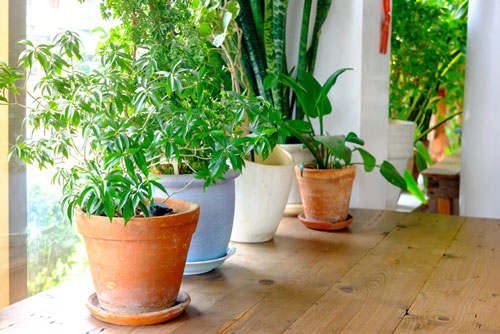For years, we were told that houseplants helped purify indoor air. This makes sense since plants consume the pollutant carbon dioxide and produce oxygen.
The strongest evidence for the ability of potted plants to improve the indoor environment came from a NASA study. In 1989, the space agency ran an experiment that showed plants could remove cancer-causing toxins from the air.[1]
About a dozen later studies backed up those results.
But a new analysis shows that isn’t the whole story…
Scientists at Drexel’s college of engineering reviewed 30 years of research. They found that plants do absorb volatile organic compounds (VOCs), a type of air-borne pollutants.[2]
But then they looked at plants’ “clean air delivery rate.” That’s the time it takes for the air to become free of pollutants. They found that regular ventilation and air circulation dissipate VOCs much faster than plants can.
The problem is that the NASA test and the others were done in a chamber in a lab…a sealed environment without natural air ventilation. The experiments were completely different than real-life conditions in a home or office building.
Under normal conditions, researchers calculated that it would take between 10 and 1,000 plants per three square feet of floor space to equal the cleaning effects of air conditioning or simply opening a couple of windows.
In other words, if you relied on plants to purify indoor air, your home would be so full of vegetation that there would be little room for anything else.
The Best Way to Clean Indoor Air
Houseplants look nice but don’t expect them to make a difference in the air you breathe. And air conditioning or open windows won’t entirely do the job either…especially since many pollutants originate from outside your home.
Instead, get an air filter.
Indoor air pollution has various sources. Stoves, heaters, and fireplaces all emit some carbon monoxide, even if vented properly.
Carpeting, furniture, and other products with artificial fabrics off-gas formaldehyde and other chemical solvents.
Electronics emit phthalates, which are tied to hormonal problems. Damp bathrooms and kitchens can be sources of airborne molds.[3] [4]
Indoor air filters can be very effective. The most convenient way to clean the air is to add a HEPA filter system to your furnace and/or air conditioning system.
HEPA stands for “high efficiency particulate air.” This means they capture ultrafine particles, including just about all air pollutants.[5]
You can also buy stand-alone filters, which are less costly than whole-house systems. But before you buy, you should check the purifier’s rating.[6]
Air Filter Rating Systems: What You Need to Know
Different manufacturers use different rating systems that show how much pollution a purifier removes from the air. Here are three of the most common rating systems:
- MPR. This is the Micro-Particle Performance Rating system developed by 3M, a company that makes filters. The best filters have MPR ratings between 1,500 and 1,900.
- FPR. Home Depot uses its own 1 to 10 rating system called the Filter Performance Rating. The higher the number, the better the filter.
- MERV. Many whole-house filters list the Minimum Efficiency Reporting Value developed by the American Society of Heating, Refrigerating, and Air-Conditioning Engineers. The higher the number, the better the filtration. You want a MERV higher than 10.
The purity of air you breathe is as important as the quality of the food you eat and water you drink. Do your lungs—and the rest of your body—a favor. Make sure the air in your home is clean and safe to breathe.
Editor’s Note: Discover the most effective natural methods to protect and improve your health. Read Independent Healing. It’s your best source for unbiased, evidence-based health information you won’t find anywhere else.
Related Articles
Breathing the Air in 6 U.S. Cities Is Like Smoking a Pack a Day
It’s in the Air…and It Gives You Dementia
The Invisible
Toxin That’s Damaging Your Heart
Like this Article? Forward this article here or Share on Facebook.
[1]https://www.eurekalert.org/pub_releases/2019-11/du-sap110519.php
[2]https://www.eurekalert.org/pub_releases/2019-11/du-sap110519.php
[3]http://www.care2.com/greenliving/7-sources-of-indoor-air-pollution.html
[4]https://www.atsdr.cdc.gov/csem/csem.asp?csem=33&po=7
[5]https://www.consumerreports.org/cro/air-purifiers/buying-guide
[6]https://www.consumerreports.org/cro/air-filters/buying-guide

